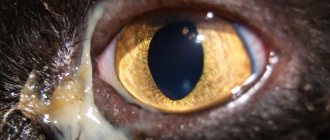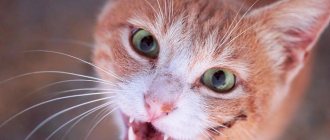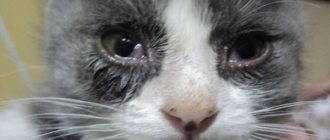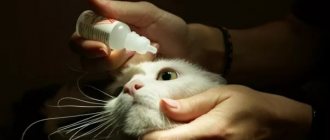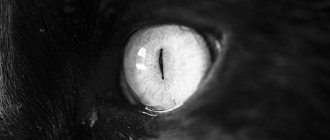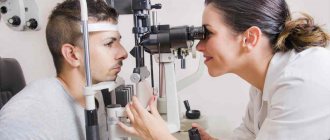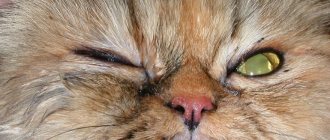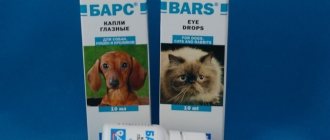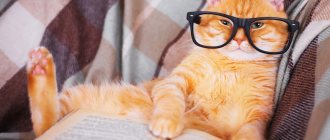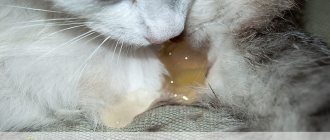Every pet owner must monitor the health of their pet. It is necessary not only to feed the cat well, but also to carry out hygiene procedures - bathe in a timely manner, clean the ears and wipe the eyes.
In the absence of hygiene, the pet often develops pathological processes in the eye area, causing the appearance of purulent exudate.
The main reason for the appearance of pus from the eyes of cats is inflammatory processes in the area of the conjunctival membrane, which were not eliminated in a timely manner.
The factor that provoked the development of the disease must be established in a veterinary clinic, where the animal will undergo all the necessary diagnostic procedures and be prescribed adequate treatment.
Causes of pus in the eyes of cats
All causes of eye suppuration in cats can be divided into several large groups:
- Mechanical damage to the retina. Accompanied by temporary inflammation followed by watery discharge. The latter accumulate in the inner corners of the eye in the form of small, hard brown or black lumps.
- Chemical exposure that causes an animal to develop blepharitis (inflammation of the edges of the eyelids).
- Colds or allergies are often accompanied by clear or white mucous discharge from the nose and eyes.
- The body's response to the action of pathogenic microorganisms. The discharge is yellowish-green in color and is recognized by the specific smell of pus.
- The result of a complication of conjunctivitis that occurs when a veterinarian is not consulted in a timely manner.
- Helminthiasis. In addition to the main parasitic factor, helminths poison the animal’s body with the products of their vital activity. As a result, an allergic reaction occurs, accompanied by mucus from the nose and suppuration of the eyes.
We recommend reading the article about eye diseases in cats to understand the topic in more detail.
Causes
Festering eyes are not an independent disease, but only a symptom, and veterinarians identify many causes.
One of the most common is ophthalmological pathologies:
- Conjunctivitis is a harmless disease that is an inflammation of the mucous membrane of the eyes.
- Keratitis is damage to the cornea due to trauma, burns with chemicals, infections, and allergies.
- Blepharitis is an inflammation of the edges of the eyelids caused by bacteria.
- Injuries to the mucous membrane. Minor damage heals on its own. In large wounds caused by sharp objects (claws, branches), an inflammatory process with suppuration of the eyes may occur.
Often kittens are born with pathologies of the organ of vision. The defects cause watery eyes and discharge of pus. So, the baby may lack a lacrimal punctum, the lower eyelid may turn inward, eyelashes may grow in several rows, etc. Other causes of suppuration include:
- poor quality care, lack of hygiene;
- unbalanced diet;
- decreased immunity;
- colds caused by drafts and hypothermia;
- allergy;
- atopic dermatitis;
- chlamydia;
- heredity.
The eyes can fester in any animal, regardless of gender and age. Breeds such as Scottish, British, and Persian are especially susceptible to this pathology. This is explained by the anatomical features of the skull.
Symptoms
An experienced owner always pays attention to the behavior of his pet. Symptoms:
- Loss of appetite, general lethargy, increased sleep duration.
- Increased body temperature.
- Preference for dark, secluded places due to increased sensitivity to light.
- Squinting or closing your eyes most of the time.
- The presence of a specific odor.
- The appearance of a rare cough, redness of the mucous membrane, runny nose.
Diagnostics
If primary suppuration occurs, the owner should immediately contact a qualified specialist, preferably a specialist, an ophthalmologist. Time and strict adherence to the doctor’s instructions play an important role in the favorable outcome of treatment.
You should take eye diseases in newborn kittens especially seriously, because... complications later will pose an even greater danger.
Without laboratory tests and an integrated approach, it is impossible to be sure that the diagnosis is correct. Unfortunately, not all owners remember this, preferring self-medication at home to an experienced veterinarian.
Panophthalmitis
The disease, although not so common, is very serious. This disease affects the entire eye organ and is accompanied by profuse suppuration. Most often, this pathology occurs in cats that lead a wandering lifestyle, but there are also cases of diseases in domestic pets. With this disease, in addition to purulent discharge, the animal’s eyeball itself enlarges. Unfortunately, there is currently no treatment. The problem can be solved exclusively by surgery - removal of the eyeball. As we can see, there are many diseases that affect a kitten’s eyes and, unfortunately, not all of them are curable. Therefore, it is extremely important to provide your pet with timely assistance and prescribe the correct treatment. Under no circumstances should you self-medicate - any seemingly frivolous process, characterized by inflammation in the eyes of a cat, can develop into a critical form and lead to blindness.
Treatment methods
It is important to remember that the success of recovery directly depends on the accuracy of the diagnosis and the person’s willingness to fully comply with the instructions.
Recommendations:
- For a complete diagnosis, the doctor requires an anamnesis, i.e. information about the cat: what conditions the pet lives in, its diet, previous diseases, behavioral characteristics, proximity to other animals.
- It is advisable to wash your cat’s eyes with a warm chamomile solution before visiting the veterinary clinic.
- Depending on the causes of suppuration, the doctor may use several treatment approaches. In case of prolonged and profuse discharge from the eyes and nose, as a rule, a novocaine blockade with the administration of an antibiotic is prescribed. If discharge from the eyes is the result of mechanical damage, use Levomycetin drops for an adult cat or Albucid for one-month-old kittens.
Bruises and wounds of the eyelids
These are mechanical damage to the integrity of the integument that could have been caused by an animal, for example, from a scratch with a claw. This case is characterized by violations of the integrity of the tissues around the affected area. In severe cases, necrosis of the affected area may occur. The area of such a bruise swells, becomes painful and hot to the touch. If there is a wound on the eyelid, damage and bleeding are visible to the naked eye. Like any other, such a wound is an open gate for infections. Therefore, it is very important to provide timely assistance to your pet, without bringing the condition to a critical level, namely: thoroughly clean the affected area of dirt using gauze swabs and a 3% hydrogen peroxide solution. It is important to understand that the procedure must be carried out with the utmost care to avoid additional damage. After cleaning the kitten’s eyes, they are washed with a solution of potassium permanganate and then drugs containing antibiotics are instilled into them. A doctor should prescribe such drugs, since by acting at your own discretion, you risk not only not providing the help your pet needs now, but also aggravating the situation.
Read more: How to treat wounds on a cat
List of recommended drugs
Based on the causes of the disease, the veterinarian most often prescribes the following medications:
- For bruises and injuries - drops of Levomycetin or Iris.
- For swelling - a solution of hydrocortisone and novocaine.
- For acute illness - intramuscular antibiotics.
Prescribing medications for an animal should only be done by a professional after a complete diagnosis. Self-treatment without the guidance of a veterinarian can lead to complications and irreversible pathologies.
Tips for beginners when washing eyes
Eye washing is one of the most important points in the treatment and prevention of disease in any animal.
You can do the procedure yourself at home or go to a veterinary clinic. During a period of illness, a cat is most often reluctant to allow its owner to approach it.
Representatives of the Persian, British and Siamese breeds are especially capricious. In this situation, it is advisable to ask a family member to hold the cat's head during the procedure. It is best to secure it with a towel or diaper.
Recommendations:
- A folded cotton pad or a tight tourniquet is suitable for rinsing. It is better to avoid cotton swabs, as they do not absorb liquid well, have a relatively small surface and can damage the retina when the animal tries to escape.
- For sterility purposes, it is better to prepare separate dishes for washing each eye. For the same reason, you should use a cotton pad no more than once.
- It is not recommended to touch the inflamed surface with a dry disc.
- Hands must be washed.
- All solutions must be at room temperature.
- Keep in mind that a swollen area can often cause pain for your cat.
- The best treatment is comprehensive. After rinsing with the solution/drops, re-treat the inflamed area with ointment.
- You need to repeat washing as often as possible. Step-by-step instructions for washing eyes
- Fix the animal on its side, turning its head up, holding the chin.
- If a crust forms and the eye sticks together, soften the inflamed area with Vaseline oil. Using cotton wool soaked in 3% hydrogen peroxide, remove the discharge, then rinse with the solution and apply eye drops.
- Apply the solution to the eyeball, gently lifting the eyelids.
- Raise and lower the animal's eyelids several times to distribute the medication evenly. Remove excess with a disc.
- Do not forget about nasal discharge, remove it with a cotton pad.
What to do at home
The owner must follow the veterinarian's instructions. Self-medication is dangerous and can make the situation worse.
You can wash your cat's eyes with chamomile decoction, boric acid solution, or furatsilin. The pet is unlikely to accept this manipulation with delight, so it is advisable to perform the procedure together: one person holds the cat, the second treats its eyes, and then instills the drug.
The solution used must be warm. Rinsing is carried out with a cotton pad, twisted into a tourniquet, until the pus from the eye is completely removed. Only after this the drug is used.
You cannot use a dry pad or cotton swabs, as they can injure your eyesight.
Types of tinctures and solutions
Eye solution can be purchased at a pharmacy or prepared independently.
The most effective are:
- Camomile tea. Dilute one tablespoon of dried flowers in a glass of boiling water. Leave for 30 minutes.
- A decoction of strong tea. It is advisable to use whole leaves and distilled water.
- Table salt solution. For a liter of distilled water, take 1/2 teaspoon of salt. The mixture is brought to a boil. Not suitable in case of an allergic reaction.
- Lacrimin or Medkinos solutions, which can always be purchased at a pharmacy at an affordable price.
Medications
- Hydrocortisone drops with novocaine - to relieve swelling, inflammation, pain.
- Gentamicin drops - for severe inflammatory processes.
- Albucid drops - for the treatment of injuries.
- Drops with chloramphenicol - for infectious lesions.
- Drops with atropine - for the development of photophobia.
- Solcoseryl ointment - for healing mucous membranes in case of injuries.
- Tetracycline ointment for allergic reactions, to relieve inflammation.
Choosing eye drops
Unlike infusions, it is impossible to prepare drops at home. You can find the necessary remedy at a veterinary or regular pharmacy.
It is important to remember that neither solutions nor drops can provide a 100% healing effect. The latter are necessary only to slow down the development of the disease.
The most commonly prescribed drugs are:
- Sulfacetamide.
- Levomycetin drops.
- Diamond eyes.
Selection of ointments and method of their use
For best effect, it is recommended to use ointments. As a rule, tetracycline ointment (1%) is used.
Apply it as follows:
- First, purulent discharge from the eyes and nose is removed. Gently wash the inflamed areas with a cotton pad soaked in tincture or solution.
- To enhance the effect, the ointment is warmed to room temperature in advance.
- Lightly pull back the cat's lower eyelid, apply ointment to its inner surface, placing the latter with a special spatula.
- The eyelids are closed, massaging in a circular motion to better distribute the ointment over the surface of the swollen eye.
- Remove excess with a cotton pad.
Preventive measures necessary to avoid eye diseases
Vaccinations and periodic deworming are universal ways to protect any animal. It is also important to consider the breed of the cat.
Some of them, such as the Sphynx, require increased attention to the skin. Having no fur, they are more susceptible to suppuration. Not only do they require daily care and eye washing, but they also need to repeatedly wipe their ears with a warm solution.
The opposite situation is the Persian breed with thick hair. In case of suppuration, snot and other mucous secretions, you should cut off the hair around the swollen organ and, after recovery, carefully ensure that the hair does not fall into the area of the former inflammation.
If infected, you should not allow the infectious animal to come into contact with your child or healthy pets; it is also important to remember your own safety measures when treating your eyes.
If the cause of eye discharge is an injury, then it is better to make an appointment with a veterinarian, undergo a full course of treatment, and also see a doctor regularly after that (preferably every month).
Daily animal care is the key to health. As a rule, it is difficult to train an adult cat to wash its eyes. However, for some breeds such safety measures are simply necessary due to their anatomical features, for example, Scottish Folds. Therefore, it is better to accustom your cat to such procedures from the first weeks of life.
Symptoms
It is impossible not to notice that a cat’s eyes are festering. As a rule, suppuration is accompanied by other signs. Cats are very clean, so discharge causes them great discomfort. The animal blinks frequently and constantly rubs its muzzle, trying to get rid of dried crusts.
The eyes become red, swollen, watery, and yellow, green or brown pus is released from them. The fur near the eyelids darkens and a dense crust forms around it, preventing the cat from opening them completely.
A previously active and cheerful pet becomes lethargic, apathetic, refuses to eat, and tries to hide in a dark place, away from the light. In some cases, the temperature rises.
If you notice purulent discharge from your four-legged pet, you should immediately contact a veterinarian. If this is not possible, then you need to rinse the eyes, but still show the animal to a specialist.
Street cats
The reason for the prevalence of eye diseases among street cats is the lack of normal living conditions. Frequent fights, lack of medication, constant contact with other animals, poor diet, temperature changes and other factors cannot have a beneficial effect on recovery. As a rule, environmental conditions only aggravate the situation and lead to serious consequences.
Adopting a stray cat is easy. However, one should always be aware of the level of responsibility that a person takes on with such a decision.
In most cases, street cat diseases are in late stages, so the treatment period can take a long time and cost a lot of money.
At the same time, homeless animals are the most loyal creatures in the world, unlike many purebred animals. Such a cat will be grateful to its owner and can become his best friend.
1111
